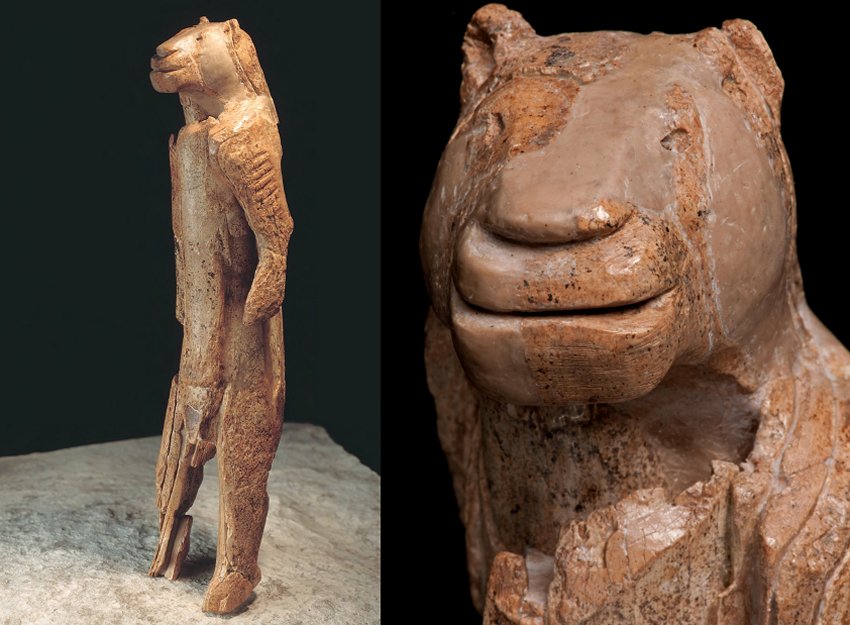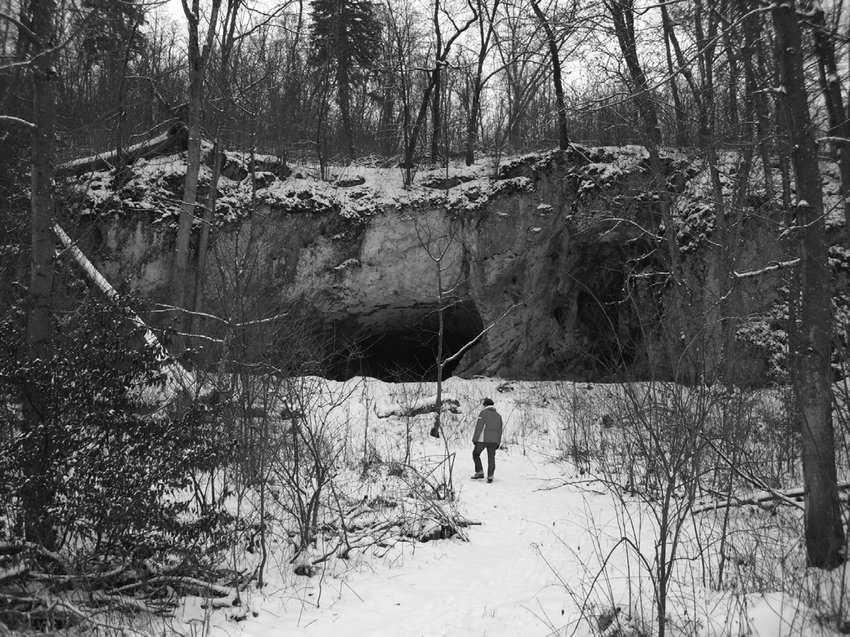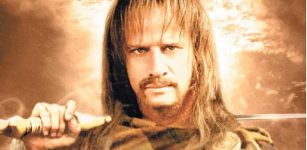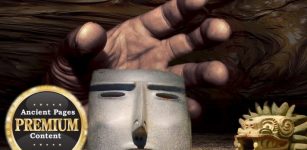Enigmatic Figure Dated Back To 40,000 From Prehistoric Stadel Cave, Germany
A. Sutherland - AncientPages.com - On August 25, 1939, archaeologists working at a Paleolithic site called Stadelhole ("stable cave") at Hohlenstein ("hollow rock") in the Lone valley, southern Germany, uncovered hundreds of mammoth ivory fragments.
About 40,000 years ago, at the beginning of the upper paleolithic period, the Swabian Jura was part of the living area of the early, anatomically modern, humans (homo sapiens).
Archaeologists found evidence that these prehistoric people, lived in several caves: they used campfires, tools, weapons and jewelry made out of stone, bone, antlers and ivory.
Moreover, they also sculptured small figurines depicting dangerous animals such as cave-bears and cave-lions, using stone tools out of mammoth ivory.
The tallest and most spectacular of the ivory figurines is the Lion Man, a fabulous therianthropic creature.

For more than 70 years, archaeologists have been piecing together the 'Lion man' out of mammoth ivory fragments.
Unfortunately, just one week later, before archaeologists could complete their fieldwork and analyze the finds, World War II began. The team was forced to quickly fill the excavation trenches using the same soil in which they found the ivory pieces.
Among the fragments, there were several pieces of the so-called 'Lion man' - one of the oldest and certainly one of the most remarkable statuettes in human history.
For more than 70 years, archaeologists have been piecing together the fragmented sculpture of 'Lion man' out of mammoth ivory fragments.
Their work took time because important parts of the figurine were still missing.
Surprisingly, in 2009, new excavations inside the Stadel Cave rediscovered of the original finding place of the ‘Lion Man’ fragments unearthed in 1939.
They were able to retrieve numerous additional fragments of the figure. It's the tallest and most spectacular of the ivory figurines discovered in four caves. The figurine that combines animal and human attributes, is 29.6 cm (11.7 inches) in height, 5.6 cm wide, and 5.9 cm thick.
The animal part is represented by the lion-head, the long shaped body and the arms formed as forelegs and paws of a big cat, the human part by the legs and feet, as well as the upright position.
 Hohlenstein-Stadel Cave: The entry to the Stadel Cave is located only a few meters above the valley floor and is not visible from the Vogelherd. The Löwenmensch statuette was found in a deep section inside this cave and was intentionally deposited. Photo by Martin Porr
Hohlenstein-Stadel Cave: The entry to the Stadel Cave is located only a few meters above the valley floor and is not visible from the Vogelherd. The Löwenmensch statuette was found in a deep section inside this cave and was intentionally deposited. Photo by Martin Porr
It's unclear whether the figurine represents a man or a woman. From time immemorial, the lion has been viewed as a symbol of the masculine virtues of courage and strength. Shamans still exist today in the Amazon region and Australia. Most of them are men.
On the other hand, the figure has some perplexing features. The navel, for example, a symbol of childbirth, is especially pronounced. A horizontal crease runs across the lower abdomen, a feature that is typically female.
The ‘Lion Man’ - currently on display in the City Museum of Ulm, in Germany - represents a unique relic, carved out of woolly mammoth ivory using a flint stone knife.
It is also very early prehistoric sculpture dated back to the Upper Paleolithic of about 40,000 BC.
Written by – A. Sutherland AncientPages.com Staff Writer
Copyright © AncientPages.com All rights reserved. This material may not be published, broadcast, rewritten or redistributed in whole or part without the express written permission of AncientPages.com
Expand for referencesMore From Ancient Pages
-
 Change Of Burial Tradition Among The People of Early Medieval Europe
Archaeology | Aug 6, 2021
Change Of Burial Tradition Among The People of Early Medieval Europe
Archaeology | Aug 6, 2021 -
 3,500-Year-Old Tomb Of Egyptian Goldsmith Discovered
Archaeology | Sep 10, 2017
3,500-Year-Old Tomb Of Egyptian Goldsmith Discovered
Archaeology | Sep 10, 2017 -
 Priam’s Treasure – Authentic Trove From Homeric Troy Or Deception?
Artifacts | Jun 11, 2021
Priam’s Treasure – Authentic Trove From Homeric Troy Or Deception?
Artifacts | Jun 11, 2021 -
 Ancient Egyptian Blue Used To Create New Nanomaterial 100,000 Times Thinner Than A Human Hair
Ancient Technology | Mar 24, 2020
Ancient Egyptian Blue Used To Create New Nanomaterial 100,000 Times Thinner Than A Human Hair
Ancient Technology | Mar 24, 2020 -
 Lost Ancient Texts Of The Star Catalogue Composed By The Greek Astronomer Hipparchus Found
News | Feb 21, 2023
Lost Ancient Texts Of The Star Catalogue Composed By The Greek Astronomer Hipparchus Found
News | Feb 21, 2023 -
 Human-Driven Mass Extinction Is Eliminating Entire Branches Of The Tree Of Life – New Study
Biology | Sep 19, 2023
Human-Driven Mass Extinction Is Eliminating Entire Branches Of The Tree Of Life – New Study
Biology | Sep 19, 2023 -
 Vercingetorix: Greatest Of All Gallic Leaders And Hero Of The French People
Featured Stories | Jun 24, 2020
Vercingetorix: Greatest Of All Gallic Leaders And Hero Of The French People
Featured Stories | Jun 24, 2020 -
 Enigma Of Giant Statue Of Kouros Of Apollonas
Featured Stories | Jul 18, 2019
Enigma Of Giant Statue Of Kouros Of Apollonas
Featured Stories | Jul 18, 2019 -
 Eye Of Providence – Powerful, Secret Symbol With Deep Meaning
Ancient Symbols | Feb 13, 2018
Eye Of Providence – Powerful, Secret Symbol With Deep Meaning
Ancient Symbols | Feb 13, 2018 -
 Tír na nÓg – Mythical Land Where Time Floats Slower Than In Mortal Lands
Celtic Mythology | Mar 2, 2020
Tír na nÓg – Mythical Land Where Time Floats Slower Than In Mortal Lands
Celtic Mythology | Mar 2, 2020 -
 Spectacular Find: Lost Temple Of Goddess Artemis Has Been Found On Greek Island Of Euboea
Archaeology | Sep 22, 2017
Spectacular Find: Lost Temple Of Goddess Artemis Has Been Found On Greek Island Of Euboea
Archaeology | Sep 22, 2017 -
 Pax Romana: 200-Year-Long Period Of Stability Within The Roman Empire
Ancient History Facts | Apr 19, 2016
Pax Romana: 200-Year-Long Period Of Stability Within The Roman Empire
Ancient History Facts | Apr 19, 2016 -
 Birth Of Good And Evil In Iroquois Beliefs
Featured Stories | Sep 23, 2019
Birth Of Good And Evil In Iroquois Beliefs
Featured Stories | Sep 23, 2019 -
 Legendary Lost Island Of Gold Of The Mysteriously Vanished Srivijaya Civilization Found Underwater
Archaeology | Oct 25, 2021
Legendary Lost Island Of Gold Of The Mysteriously Vanished Srivijaya Civilization Found Underwater
Archaeology | Oct 25, 2021 -
 Relics From Day-To-Day Life At Shakespeare’s Home – Now Shown In New Virtual Exhibition
Archaeology | Dec 11, 2020
Relics From Day-To-Day Life At Shakespeare’s Home – Now Shown In New Virtual Exhibition
Archaeology | Dec 11, 2020 -
 Ancient Mysteries Of Wisconsin – Great Forgotten Prehistoric Events Shed New Light On History Of North America
Ancient Mysteries | Jan 11, 2019
Ancient Mysteries Of Wisconsin – Great Forgotten Prehistoric Events Shed New Light On History Of North America
Ancient Mysteries | Jan 11, 2019 -
 Evidence Europeans Made Leather Clothing 40,000 Years Ago – New Study
Archaeology | Apr 17, 2023
Evidence Europeans Made Leather Clothing 40,000 Years Ago – New Study
Archaeology | Apr 17, 2023 -
 Prehistoric Humans Recycled Old Stone Tools To Preserve The Memory Of Their Ancestors
Archaeology | Mar 17, 2022
Prehistoric Humans Recycled Old Stone Tools To Preserve The Memory Of Their Ancestors
Archaeology | Mar 17, 2022 -
 Untold Story Of Mexico’s Ancient Giant Indians – Secret Knowledge Of The Aztecs Revealed – Part 1
Ancient Mysteries | Sep 21, 2019
Untold Story Of Mexico’s Ancient Giant Indians – Secret Knowledge Of The Aztecs Revealed – Part 1
Ancient Mysteries | Sep 21, 2019 -
 Scientists Reconstruct The Climate Of The Ancient World Using Small Wooden Artifacts And Mummies
Archaeology | Apr 5, 2023
Scientists Reconstruct The Climate Of The Ancient World Using Small Wooden Artifacts And Mummies
Archaeology | Apr 5, 2023


